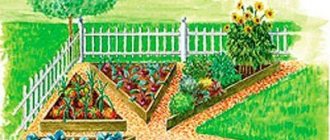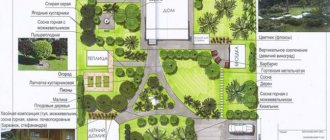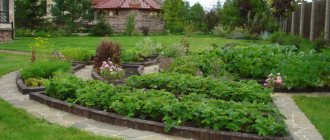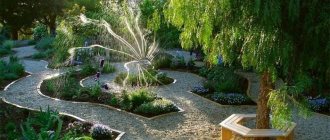Before planting plants in open ground, you need to draw up a planting plan. This will help avoid many mistakes, and a pre-planned garden will look much more harmonious than a hastily planted one.
Your planting plan can look like anything you want: a handwritten list or an entire map. We suggest doing something in between: a schematic sketch that includes all the necessary information.
This plan will help you maintain proper crop rotation. After all, by saving the diagrams for several years in a row, you will be able to accurately change the location of crops in the beds. In addition, you will have the opportunity to choose your neighborhood more carefully. By planning everything in advance, you will get a well-planned garden that is a pleasure to care for.
Choosing a place for a garden
Most plants love sunlight. Then they grow and bear fruit normally. It is necessary to choose a place for a vegetable garden taking into account this fact. It is especially important to allocate a well-lit area for a vegetable garden in the middle zone and northern regions.
It will be beautiful and convenient if you do everything according to the rules
Before planning, take a closer look at how the shadow is distributed on your site during the day. It's not just buildings that are throwing it off. Another shade is provided by a solid fence, trees and bushes. Based on the results of your observations, divide the area into three groups: illuminated all daylight, until noon, and all day in the shade.
You need to choose a place for a vegetable garden taking into account the amount of sunlight on the site
For regions with a cool climate, the best place for a vegetable garden is where the sun shines all day long. In the south, choose other areas - in partial shade. For southern regions, it is ideal if there is sun only in the morning, and in the afternoon the area is covered in shadow. Where there is shade throughout the day, only shade-loving plants can be planted. There are few of these in the garden, but there are enough flowers or ornamental plants. So you can make a flower bed.
Recommendations from experienced gardeners and gardeners
Experienced plant growers know all the nuances of working in home gardens. To get a good harvest, you need to adhere to many rules, know the features of crop rotation, and the nature of the crops grown.
Here are some tips from experienced gardeners about plot arrangement:
- It is preferable to use small greenhouses no more than 6 meters long on the site. The fact is that long greenhouses have a “dead” zone in the middle, in which such a steam room is formed that it is difficult for the plants. Therefore, shorter “houses” are much more convenient.
- A greenhouse installed in the north-south direction warms up well in the eastern sun.
- If you install a couple of rows of greenhouses side by side, you can provide a good fence for the area from prying eyes.
- It is best to arrange the trees like chess pieces. The triangular design allows for better care of fruit trees. At the same time, if a gap of 6 meters is needed between tall trees, then three or four are enough between plants of medium height.
- It is advisable to plant cherries on the south side of the site. The same rule applies to plums.
- If they want to grow walnuts on the plot, then they choose a place for it near the house, away from other fruit crops.
- For plums, you need to find a place where there is not a lot of snow. If the tree trunk is covered in snow, this will have a detrimental effect on the plant.
- Currants - white and red - need light, so these bushes cannot be planted where black currants are blissful - in partial shade.
- Strawberries will produce a good harvest only in a well-lit place, closed from drafts.
- Trees that have different periods of ripening and fruiting, but are planted close to each other, feel bad. Winter and summer fruit varieties are not in good harmony, so productivity suffers.
Natalia
Author
Ask a Question
If you approach the planning and arrangement of your garden plot wisely, you can create a favorable environment for crops that will thank the gardener for his care with a good harvest.
How many beds do you need?
To plan a vegetable garden, you need to know how much area you will need to allocate for each type of plant. When you decide on the area, you can, already in the planning process, choose the size of the beds and their shape. So, how many beds do you need? First of all, you must decide what you want to grow in your garden and how many kilograms you would like to have of each crop. The easiest way to do this is in table form.
| Vegetable crop | Productivity in kg per hundred |
| Potato | 250-300 kg |
| Carrot | 230-270 kg |
| Cabbage | 500-600 kg |
| Beet | 300-370 kg |
| Onion | 100-120 kg |
| Tomatoes | 60-70 kg |
| cucumbers | 350-420 kg |
| Eggplant | 200-350 kg |
| Bell pepper | 150-200 kg |
Then you need to find data on yield per acre in your region. You need data for each type of plant you want to grow. The table shows the average yield for Russia. They counted them into kilograms per hundred square meters. They will differ by region, and significantly. But for a first estimate, you can take these numbers. After the first harvest, adjustments can be made. You can also try to find out from your neighbors how many vegetables they grow and focus on local indicators.
Calculation of the area of beds for crops
All you need to do to calculate the area for beds is to divide the figure that you plan to receive in the form of a harvest by the yield for a given crop. Find out how many acres should be allocated for this vegetable. Then, when planning your garden, decide on the length and width of the beds, then you can finally understand how much space is required.
Two vegetable gardens. Both there and there have everything you need. It all depends on preferences and the required volumes of grown products
Let's look at it with an example. For example, we want to grow 250 kg of potatoes, 50 kg of onions, 50 kg of tomatoes and 50 kg of cucumbers. We count:
- Potato yield is 250-300 kg per hundred square meters. We still want the same 250 kg. That is, we will allocate 1 hundred square meters for potatoes.
- We want 50 kg onions. Productivity - 100-120 kg. We count: 50/100 = 0.5 hundred parts.
- You need 50 kg of tomatoes. Productivity 60-70 kg. Calculation: 50/60 = 0.8 acres.
- We plan to get 50 kg of cucumbers. The yield is 400 kg, we get 50/400 = 0.125 acres.
We calculate in the same way for all the plants that we want to grow in the garden. We add up the resulting numbers and compare the result with the area that we can allocate for a vegetable garden, and make adjustments.
This is if you do it “according to science.” If gardening is more of a pleasure for you, then take a plot plan to scale, and on the same scale make templates for beds of different shapes and sizes. Move the beds around the area until you get a picture that you like. Then simply distribute the vegetables among the beds. But even in this case, lighting must be taken into account.
There is no gain in space, but it looks interesting and the lighting could be better
Location of beds
If we talk about orientation to the cardinal points, then the most optimal placement of the beds is from north to south. In this case, the planting will be illuminated all day long, and shading will be minimal. But this is true for regions with cool summers. In the southern regions the problem is different. It's not about how to get better lighting, but how to stop the sun from burning your plants. The task is the opposite, but it is no easier. The advantage here is that the orientation of the beds is not so important.
You can plant plants both along the long side of the bed and along the short side.
Northern regions
The choice of location for vegetable crops is also influenced by the location of the region and the presence/depth of groundwater. Recommendations for northern regions:
- Arrange the beds from north to south.
- We make sure that the shadow of the house or trees falls on the garden as little as possible.
- When the water level is high, we try to allocate the highest areas for the garden or make ditches around the perimeter to drain the water.
- We arrange high or raised beds.
Still, it’s easier to achieve beauty with fenced-off beds.
These are general principles and rules. See for yourself what suits you and what doesn’t. As for raised beds, it is worth saying that they require more time and money to set up. But they justify themselves. Firstly, they warm up earlier, and secondly, soil waters and substances dissolved in them have minimal impact on plants. Thirdly, the gardening season can be extended, since it is easy to make something like a greenhouse by making arcs on which to stretch the covering material. This will also protect the crop from sudden frosts.
Vegetable garden in the south
For the southern regions, the layout of the vegetable garden is subject to different principles. It is necessary to protect the plants from the scorching sun and ensure normal watering. Here's what you can do:
- We plant plants that tolerate heat well in direct sun. These are sweet peppers, eggplants, tomatoes.
- Plants with more delicate foliage are planted in partial shade or alternating with tall crops that will shade them. For example, cucumbers can be alternated with corn. Two or three rows of cucumbers, one of corn. And along the edges of the planting there is also corn.
If there is a lot of sun, at least position it radially - Drip irrigation is more efficient and economical.
Raised beds in the south are also applicable, but really high and with light walls (whitewashed). The reasons here are different. In the southern regions with dark soil, it heats up so much that it is impossible to walk barefoot - it feels like being in a frying pan. With raised beds, you raise the plants above the hot soil. Well, it’s easier to shed a limited volume of soil. In addition, you can also install arches and stretch covering material or shading mesh to protect from the scorching sun.
Cultivation method and width of beds and row spacing
Not all gardeners divide their plots into beds. Many people simply plant plants in rows, not even always separating one crop from another. Sometimes the division is a wider “pedestrian” row spacing. In principle, this is possible, but dividing it into beds makes it easier to care for and makes the garden more attractive. When properly processed, it increases productivity.
Who said it should only be smooth?
How to plan a vegetable garden for beds
There are several systems for dividing beds. They determine the width, planting length, and some also the row spacing.
- Narrow beds. The width of the beds is 45 cm, the distance between them is 90 cm. Why is this so? In a regular bed, the outer plants are usually taller and stronger because they receive more light. For this reason, they make a bed 45 cm wide, planting only two rows of plants. In this way, high yields can be achieved; even sun-loving varieties ripen in the middle zone. But there is also a significant disadvantage: wide row spacing reduces the “working” area, and they are also overgrown with grass, which has to be dealt with.
The famous gardener Igor Lyadov grows a sumptuous harvest in narrow beds - Normal beds or regular width - from 50 cm to 90 cm or even up to 1 meter. The row spacing ranges from 40 cm to 60 cm. They can be level with the ground or raised. Raised - these are without walls, but the sowing area is higher than the level of the row spacing. The height difference is formed due to the soil brought in or the site added from other places.
- Raised beds. The walls are made of boards, slate or other similar material, and humus and a layer of earth are poured inside the box. Such beds are not flooded by floods or rains and warm up better. They are more comfortable - easier to handle, no need to bend too low. But the device requires more costs and time.
Increasingly, beds occupy only part of the garden. The rest of the area is allocated for a recreation area, garden, rock garden and other similar garden “excesses” - Warm beds . They differ from tall ones in their “filling”. Inside the box made of boards or slate, layers of branches, foliage, humus, and a layer of soil are laid in which the plants are already planted. Width - up to 1 meter. The good thing is that rotting foliage warms the soil, which allows plants to be planted earlier. This is important for the northern regions; for the southern regions it is not so relevant, but also practical due to the better results that prepared soil gives.
You can use any of the methods of growing plants in beds. You can also choose any width of the bed. Optimally - no more than one meter. Possibly less. We select it individually: it is important that you can reach the middle without much difficulty. And not only to reach - you will have to handle the middle of the landing, but it should not be too uncomfortable.
Zoning when planning garden and berry plantings
The layout of a garden combined with a vegetable garden requires a clear division into functional parts. The front entrance is the face of the composition, so there is a lawn, low trees and benches here. To develop the territory, you will need recreation, planting and utility areas.
Plants
The boundaries between the functional parts of the garden and vegetable garden are planted with shrubs. Gooseberry, raspberry and currant hedges are trimmed to maintain their decorative appearance. Between the zones there are flowerpots with large plants. Screens and trellises with climbing crops will help create a beautiful fence.
Low open fences up to 40 cm in height in landscape design are planted from thuja, boxwood and juniper. A border separates a playground, vegetable garden or garden. A solid wall up to 1.5 m is erected from dwarf trees and bushes:
- barberry;
- Japanese quince;
- steppe almonds.
Fast-growing sunflowers and sloe will help create a high boundary between zones. Large varieties of flowers are used to form a green fence. Climbing perennials (roses, clematis) look impressive on trellises and arches. Over the course of the season, decorative beans and nasturtium will cover the composition with the screen.
Colors
Zoning in the landscape design of a garden is carried out using shades. Orange and blue colors are suitable for the playground, and pastel shades for relaxation. A composition of red and green lifts your spirits.
Paths
Paths not only connect different parts of the garden, but also help draw boundaries between zones. The paths from the gate to the house are made of paving stones or tiles with clear geometric shapes. Openwork solutions are used for the garden square, and colored gravel is used for the beds and flower beds. In landscape design, the imperfections of the territory can be easily masked with winding paths.
Raised beds in wooden forms Source autogear.ru
Height
When arranging a garden, dividing functional parts by a height difference looks impressive. Flowerbeds and beds are laid out at different levels. The raised space between zones is lined with stone, tiles or mosaics. A sunken area with a miniature pond or waterfall is suitable for relaxation.
Raised beds - beauty and lack of weeds Source www.dom-dacha-stroyka.ru
Forms of beds
The traditional shape of the beds is a rectangle. Its width, as you understand, is from 45 cm to 100 cm and depends only on your desire and the chosen growing method. The length of the bed again depends on your desire or on the layout of the site. Why is a rectangle most often chosen? Because this is the most efficient use of the garden area.
The shapes of the beds can be any. As in this case, they can emphasize the shape of the flower bed
In general, there can be beds of any shape: square, triangle, polygon, circle, oval and more complex shapes. These forms may look more aesthetically pleasing, but there is more space “walking around”. So you choose the shape of the beds at your own discretion. It affects the yield slightly, but the appearance of the garden is very different.
Layout of flower beds
Before arranging flower beds, you need to put them on the general plan of the site. Flower beds can occupy the entire territory of the site that remains free after building a house, laying out a garden, constructing utility buildings and small architectural forms, such as a gazebo.
Flower beds can be made in the form of:
- flower beds;
- discounts;
- mixborder;
- rosary;
- curb;
- rockery;
- stalls
Flower beds can have the correct shape of a circle, rectangle or square with a regular layout of the site and an irregular shape in the form of a drop, a trapezoid with curved edges or another shape with a landscape style. For flower beds, choose an open sunny place. Both perennial and annual flowers are planted in flower beds.
Borders and ridges are arranged along the edges of the path, around the gazebo or veranda. They are long narrow flower beds ranging from 40 cm to 2 m wide and of arbitrary length. The sizes of flowers in discounts and borders are selected depending on their width. The narrower the border or border, the smaller the flowers on it.
There are special plants designed for planting on borders and ridges, for example, border chamomile. Flowers here can be selected in several varieties or limited to one type. Borders can be used to zone space on a site.
Complex compositions such as rose gardens and mixborders require special care. Mixborder is a planting of perennials, planted in tiers. A beautiful mixborder is the result of considerable work and perfectly decorates the site.
The rose garden also requires special care and serves as the highest testament to the gardening skills of the owners. It consists of roses of one or more species. The rose garden is located in the most prominent place in the center of the site.
Rose garden.
A rockery is set up in an open area using miniature plants and stones. It is also called a rock garden. Rock gardens use plants that do not require special care, but the design of the rock garden itself involves the use of certain skills and knowledge in the field of gardening.
Parterres made from perennials are usually used in regular layouts. The ground floor consists of various geometric shapes of flowers on the lawn. The placement of flowers can be plain without a pattern or with a pattern.
You can place just one flower bed on the site or as many as can fit. A flowerbed or rose garden is usually placed near the main entrance. Edges and borders are arranged along the paths and around the gazebo.
Beds on a site with a slope
It is more difficult to plan a vegetable garden on a site with a slope. Here, retaining walls set the direction of the beds and changing something is too difficult and expensive. You have to use what you have to the maximum. On the southern slope, everything is fine - the lighting is ideal, and the retaining walls additionally warm the plantings - they accumulate heat, then warming up the air. Therefore, we make paths closer to the edge of the leveled area so that the heat from the walls reaches the plants.
Where to make paths on a site with a slope
On the northern slope, a retaining wall provides shade. It lies close to the wall almost all day, while the edge receives more sun. Therefore, we make paths right next to the wall, moving the beds to the edge of the site. In this case, it is more convenient to process plantings one level higher. This way you won't have to bend over at all.
How to make beds on an eastern or western slope? Observe which part is illuminated more and which receives less light. Make paths where there is less light.
You can also make small beds on a slope not leveled by supporting walls (example in the photo below). Install two wide boards in parallel (or knock together a couple of narrower boards). The distance between the boards is the width of your bed. Optimal - 70-90 cm.
Beds can also be made on the slopes themselves
Lay the boards on the slope “on edge”. You can dig in a little by burying the bottom edge into the ground. You hammer in pins on both sides of the board that will hold it in this position. You make mini-retaining walls from short pieces of boards and fill the voids with soil. Now you can plant the plants.
It is convenient to grow greens and aromatic crops in such beds. Suitable for strawberries, you can plant tomatoes or bush beans. In principle, the selection of crops depends on the lighting. And one more thing: plants that climb or produce a lot of volume are not very good on such a slope. And keep in mind that the walls will hardly accumulate heat, except perhaps in the spring. Later they will be covered with greenery.
Organization of watering
Vegetables need a large amount of water even in rainy areas. Many plants are sensitive to lack of moisture and do not tolerate drought well.
It is advisable to have a centralized water supply on the site, or a well or a significant water tank. Before planting, it is necessary to moisten the soil and not allow it to dry out until harvesting.
To supply water, you need a stationary water supply system, a hose with a watering can at the end, and a water irrigation installation. The water must be of appropriate quality, that is, have a certain degree of mineralization and not be very hard. You can use rainwater or use filters.
How to organize a vegetable garden in a small area
Not everyone wants to have a large garden. More and more summer residents prefer to relax at the dacha rather than cultivate the plantings. Nevertheless, going to the dacha with a full set of products is “too much” for many. Therefore, they make a couple of beds where they plant greens and a couple of bushes of various vegetables. In principle, this is a global trend, so there are more than enough ideas for organizing beds in a small space.
A mini-vegetable garden can even be organized on the terrace
Vertical beds
An interesting idea is to grow plants in vertical beds. This name hides many different methods. The only thing they have in common is that the plantings/crops are located one above the other. They may be offset or exactly one below the other, but they all tend upward and occupy a minimum of area.
Vertical plantings do not require much space
Option one is a wall for a vegetable garden. Trays and boxes with soil are hung on an existing or specially built wall or fence, in which plants are planted/sown. This is how green crops and various herbs are grown. If you want, you can plant climbing or climbing ones. But it makes sense to plant them together, providing support in the form of a mesh or wooden lattice.
Not everyone likes this idea of hanging planting boxes on the wall. You still have to water it, so the wall may get wet or the finish will be damaged. In this case, make a rack on which you place the containers. And this stand may not be near a wall or fence. It can, for example, separate a vegetable garden from a garden. Or cover some areas or buildings (in front of a toilet, shed, compost pit).
The most popular are various boxes and drawers
You can even use vertically or horizontally fixed large-diameter plastic pipes in which to cut “windows” for planting. Strawberries feel best in such plantings, but greens and aromatic plants will not be offended.
Vegetable garden along the fence
Not everyone has a fence around the perimeter of their entire plot. But if it does exist, you can make beds under it. An exception is corrugated board fencing in warm regions. The metal gets so hot that everything just burns. In the northern regions, this is not a hindrance - it will additionally heat the plants.
The method of organizing beds under the fence depends on the groundwater level, soil type and amount of precipitation. If the soil is good and the water does not stand still even after heavy rain, you can simply separate a part for planting. Dig up a bed 50-60 cm wide and place a border.
Height and material for the border - your choice
If the soil is not very good, there is a lot of water, or you just want a more well-groomed appearance, we make high beds. Add partitions and get space for greens, cucumbers/tomatoes. If you don’t want to “spoil” the fence, you can make a full-fledged box. In any case, it is covered from the inside with geotextiles. To protect against moles, you can lay a fine-mesh metal mesh on the bottom.
As mentioned above, the width of such a bed is 50-60 cm. You need to reach the far edge without much effort. And stand in this position for a while - plant, weed, water. Height is entirely at your discretion. As is the wall material.
Even a narrow passage to the house or garden can become attractive
Organizing a vegetable garden
Unlike a garden, a vegetable garden requires a site located on the sunny side. If this is not possible, it is better to abandon light-loving plants and choose plants that do not require a lot of light.
Planting vegetables will require increased rates of fertilizers, air permeability (for this you can add sawdust to the ground), irrigation, and protection from the wind by planting trees.
Organizing a garden at a summer cottage is sometimes done according to the following rules: main vegetable crops are planted at a distance from the house, herbaceous leafy vegetables are placed near the house.
A couple of ideas for small areas for a vegetable garden
If you have a small garden and you want to achieve maximum results, give preference to those plants that grow well in your region and are guaranteed to produce a harvest. It is possible to occupy squares for exotics, which probably will not survive, but only if the area is large. The same goes for time. If you can allocate minimal time to caring for your garden, you should not plant plants with complex agricultural techniques. They take a lot of time, and a positive result is not guaranteed.
From small areas to the maximum: compaction
Use the principles of compact planting - this is when another plant species is planted between plants of one type. Relevant for narrow beds or small vegetable gardens. The rules for selecting plants are as follows:
- so that they are not affected by the same diseases,
- so that food is taken from different depths,
- “compactors” mature earlier than “main” ones.
Compaction gives good results.
The landing site must also be taken into account. For example, it is better to plant salads and cabbage between rows. The remaining crops are in the same row as the main species. List of what can be sealed with:
- beets - dill, salad;
- potatoes - garlic, beans, radishes;
- cabbage - salads, dill, spinach;
- carrots - spinach, radishes;
- zucchini, squash - beans, beans, dill, corn on the cob (remove young).
What is best to compact with what in the beds
These are the most common schemes for intercropping. As you can see, there is no need to allocate a separate place for dill, radishes and salads at all. They combine well with various garden crops. Just don't sow them all at once. Optimally - with an interval of a week or 10 days, otherwise everything will reach maturity at the same time, you won’t know what to do.
Pre-sowing and post-sowing
Another way to optimize your vegetable garden is to use pre-seeding or post-seeding. Post-sowing is when new plants are planted in place of mature plants. If quickly ripening species are sown in early spring in place of late-planted species, this is called pre-sowing (pre-sowing). For previous or subsequent sowing, radishes, lettuce, greens, onions, and watercress are suitable.
There's a lot to consider
Orchard layout
When planning a garden, you need to consider the following points:
- Fruit trees should not cover decorative plantings, which means they should not be located between the house and decorative plantings.
- The garden should not block the view from the windows of the playground house.
Fruit trees do not need to be planted in a separate area, but rather distributed throughout the area.
Plant garden trees at a distance equal to at least half the diameter of the crown from the border with the neighboring plot. This is necessary so that the crown does not overhang someone else’s territory.
Principles of crop rotation
To have a harvest every year, change the areas for planting plants of the same type. For example, don't plant tomatoes in the same place every year. Pests and diseases of a specific type accumulate in the soil. By changing plants and sowing disinfectant plants, you destroy pests.
Tomatoes, eggplants, potatoes are all nightshades and have the same pests.
So when selecting plants, it is also worth looking at the classification of species. To make it easier to navigate, we present a table of sequence/combination of crops.
| Culture for planting | Good predecessors | Valid predecessors | Bad Predecessors |
| Medium and late varieties of cabbage | Peas, beans, beans, cucumber, carrots, early potatoes | Beetroot, cabbage | |
| Early varieties of cabbage, cauliflower | Onions, cucumbers, beans, peas, beans, sederats. | Carrots, tomatoes. | Root vegetables, cabbage |
| Beet | Potatoes, cucumbers, greens, green manure. | Tomatoes, onions, carrots, cauliflower and early cabbage, | Beetroot, late and mid-season cabbage |
| Cucumbers, zucchini, squash, zucchini | All legumes, onions, garlic, cabbage, except late cabbage. | Potatoes, beets, greens | Tomatoes, carrots, late cabbage. |
| Tomatoes | Cucumbers, turnips, cauliflower, greens, green manure. | Onions, beets, cabbage of medium and late varieties. | Tomatoes, potatoes |
| Onion garlic | Legumes, potatoes, cucumbers, cauliflower and early cabbage | Beets, tomatoes, late cabbage | Greens, carrots |
| Potato | Legumes, green manure, cucumbers, cauliflower and early cabbage | Beets, carrots, mid and late cabbage, greens | Tomatoes, potatoes |
| Greenery | Legumes, onions, cauliflower and early cabbage, cucumbers, green manure | Potatoes, beets, greens, tomatoes | Carrots, late cabbage |
| Legumes | Potatoes, onions, garlic, whole cabbage, cucumbers | Root vegetables, green manure, greens, tomatoes | Legumes |
How to “change” vegetables in the garden beds
If you change places for planting plants according to the table above, it is most convenient to divide the garden into 4 parts. For the first time, plant plants that have the same requirements for soil and fertilizers in a certain area. For example:
- Responsive to the addition of organic matter: pumpkin, cucumbers, squash, cabbage.
- Less demanding soil qualities: tomatoes, peppers, eggplants.
- Root vegetables (carrots, beets, turnips, turnips, rutabaga).
- Potato.
Next year we are moving everything forward. In the fall, we add humus to the area where the potatoes were. We plant plants of the first group there. Plants from the second group move to 1 plot, etc. Schematically, the first option for crop rotation for a vegetable garden is shown in the left figure below.
Correct crop rotation in the garden - what to plant next
Sometimes potatoes and tomatoes take up half the area. In this case, we divide the second half into three sections, where we place the plants of the remaining groups. Every year, potatoes/tomatoes move from one half to the other, and the vegetables in the second half also alternate with each other. This crop rotation is shown schematically in the right figure.
Recommendations for selecting neighboring plantings
All cultivated plants have “class” enemies: insect pests, viruses, bacteria, fungi. At the same time, the enemies differ in different likes and dislikes - some are eaten with pleasure, while others are bypassed a mile away. This is easy to use to protect your crop when planning your garden beds.
Experienced farmers know that beans, spinach and horseradish greatly spoil the appetite of the Colorado potato beetle, which has encroached on potatoes. Celery should not be planted next to root crops - it inhibits their growth. Wormwood spoils the taste of strawberries and wild strawberries.
Another table will help beginning gardeners find suitable bed neighbors:
Green manure
A gardener has two global tasks: maintaining or improving soil fertility and fighting weeds. There is one method that will immediately solve both problems - the use of green manure. These are plants that grow quickly and form dense greenery that suppresses the development of weeds. They are sown after or before the main sowing/planting, then the greens are cut off, leaving the roots to rot in the ground. By rotting, they enrich the soil and also make it looser. And some of the green manures also kill diseases. So this agricultural technique is really very important.
This is not out of stupidity. This is an agricultural technology to improve soil fertility
Rules of application
Several basic techniques for using green manure. They are sown immediately after harvesting in a continuous carpet (lupine, rapeseed, phacelia). Or in early spring before planting the main crops. Scatter the seeds over the surface, then cover them with a rake. Two to three weeks before planting the main plants, green manure is mowed. Greens can be used for mulching. You need to cut it before the seeds appear, otherwise you will get a new type of weed.
Growing seedlings using green manure
When planting seedlings, green manure does not need to be mowed. We just make the hole larger, plant the seedlings, and mulch the soil. If green manure covers the sun, they can be trimmed, but in general, they even out temperature fluctuations. When the seedlings have taken root, you can cut off the green manure and mulch the soil with leaves.
What types of green manure plants are there and their choice
Many plants are suitable for improving soil health. When choosing green manure, take into account what you will plant after it.
- They enrich with nitrogen almost like adding manure: alfalfa, clover, sweet clover, china, lentils, peas, beans, etc. They also kill the nematode.
- General improvement of the condition of the upper layers of the soil and the fight against nematodes: winter rye and wheat, spring oats and barley, Sudan grass, millet, fescue. Dense greens do not rot very well, but make excellent mulch. Suitable for all types of soils, including acidified ones.
Green manure plants have different properties, but they all improve soil condition
- Soil enrichment (not suitable for acidified soils): rapeseed, mustard, rapeseed, radish. The greens are soft and rot well, but they need to be mowed before the “arrows” are pasted. After green manure from this group, you cannot plant cruciferous vegetables - cabbage, radishes, radishes, spinach, arugula.
- Phacelia, mallow, amaranth, flax, calendula, tagetes (marigolds) are also good for increasing soil fertility. It is necessary to mow before the buds appear.
To suppress weeds, green manure can be sown not only in spring or autumn—row spacing can also be sown in summer. Just remember to mow on time. The greens will be used as mulch. For regions with hot climates, green manure can be planted after the main plants have taken root. In this case, dense greenery will keep the soil from overheating.
If you plant oats/barley and legumes, or flax and calendula between the potato rows, there will be fewer Colorado potato beetles and nematodes. And phacelia and mustard will help get rid of wireworms. Plant sweet clover and lupine between the tomato bushes - they will prevent horse rot and late blight from developing.
What not to put in high beds
Since a raised bed is essentially an orderly and organized compost heap covered with soil, the “forbidden ingredients” in both cases will be similar. That is, you can’t put anything in a high bed that you wouldn’t put in a compost bin: organic animal matter, leftover raw fish, fruit pits and walnut shells, weeds with seeds, cat litter and non-degradable materials.
Also, do not put leaves and tops of disease-infected plants in high beds - this will lead to the spread of pathogens to your future plantings. To prevent such a scenario, some gardeners use fungicides: they spill the “dangerous” layer with a solution of Fitosporin, HOM or SKOR and hope for the best. But whether such a risky game is worth the candle is up to you to decide!
If you have long wanted to experiment with beds in your garden, now is the time! Use our tips and you can get a high harvest with less effort and without harm to your health.











